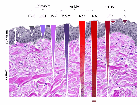

Idiomas:


Light is electromagnetic radiation which is visible by the human eye and has a wavelength between 400 and 780 nm. (1 nm = 10-9 m). Visible light constitutes a very small part of the whole electromagnetic spectrum and for instance, ultraviolet radiation covers the range from 100 nm up to 400 nm, and infrared (IR) radiation from 780 nm up to 1 mm. The UV and IR ranges are also subdivided into narrower bands (UVA/UVB/UVC and IRA/IRB/IRC). The Sun emits radiation over the whole electromagnetic spectrum but the Earth’s atmosphere blocks UVC and some UVB.
The upper layers of the skin absorb most of the UV, IR and visible light they receive. Visible and IRA radiation penetrate deepest, down to the dermis. In the eye, UVC, IRB and IRC are absorbed by the cornea so they go no further. UVA and UVB go as far as the lens. Visible and IRA reach the retina, and more so in children than in adults.
The temperature of the skin or the eye increase when they absorb radiation, particularly IR. UV can also cause chemical reactions in the body, some of which are beneficial, and some which are harmful. Radiation of a specific wavelength is absorbed by parts of molecules in the body called chromophores and this produces a photochemical reaction. UV is the most photochemically active type of radiation and is absorbed by many molecules in the skin and in the eye.
Exposure to light is measured as the energy of the radiation that is received per unit area. Exposure calculations have to consider the detailed wavelength spectrum of the incident radiation, the medium it goes through, the chemical reaction involved and how well the chromophore absorbs light of each wavelength.
Skin exposures also depend on the distance from the light source. European standards use two different types of measurements depending on the potential use of the light source:
Excessive amounts of light or heat can be harmful, and the body has methods of protection against it. For instance, very bright sources make people close the eyes and turn their face away so they are not focused on the bright light for any substantial length of time. The iris responds to bright light by constriction so it can regulate the amount of light that enters the eye. Pain and reflexes also make people move away from sources of excessive heat so they protect the skin. However, these natural aversion methods are not always sufficient to avoid damage.
The heat absorbed from light sources can be enough to damage cells permanently. Superficial damage can be repaired by new cells deep into the skin, and this process is used in some cosmetic treatments. However, deeper burns need hospital treatment and sometimes skin grafts. The eye is rarely harmed by excessive heat from domestic lamps but light from pulsed lamps and lasers can very quickly cause burns.
UV light can damage tissues indirectly by producing very reactive compounds (mainly free radicals and reactive oxygen) that go on to damage cells. The retina is very susceptible to this type of damage and is particularly vulnerable to radiation of short wavelength. The skin has agents that remove these very reactive species or repair damaged cells, and these are effective for low exposures but higher exposures can lead to cell death. The eye contains pigments that combine with reactive oxygen species and protect the retina. There are more of those pigments in the eyes of children than in older people so, with age, the retina can be more sensitive to damage, which leads to age-related macular degeneration. On the other hand, the lens becomes yellower with age and absorbs some blue light so the retinas of older people have some natural protection.
UV exposures that are not high enough to cause immediate burns can lead to an accumulation of damage and to loss of collagen and skin aging, as well as to skin cancer. Prolonged exposure of the eye to UV can make the edge of the lens cloudy and also lead to melanomas and tumors. UV and IR lights can induce cataracts.

This summary is free and ad-free, as is all of our content. You can help us remain free and independant as well as to develop new ways to communicate science by becoming a Patron!